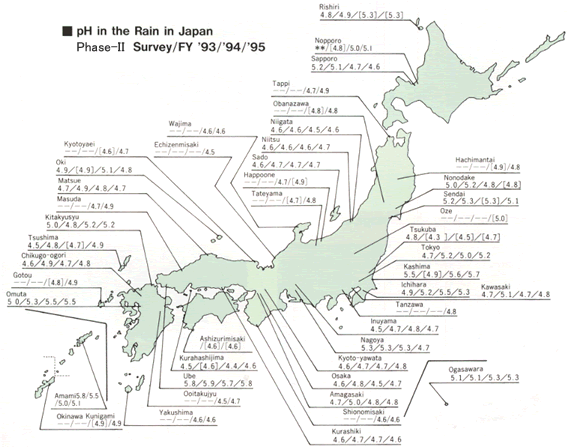Global Environment
Countermeasures against Acid Deposition
Present State of Acid Deposition
Acid deposition results primarily from the presence of sulfuric and/or nitric acids in the atmosphere. These acids are formed in the atmosphere from pollutants, such as sulfur oxides (SOx) and nitrogen oxides (NOx), generated mainly by combustion of fossil fuels. Acid deposition includes deposition in various forms of precipitation, such as rain, fog, mist, or snow (wet deposition), and deposition of acidic gases and aerosols without the intervention of precipitation (dry deposition). Acid deposition has far-reaching impacts. It affects fish and other aquatic biota due to the progressive acidification of inland waters, including marshes, lakes, rivers, and streams. Acid deposition threatens forests due to soil acidification. It accelerates and aggravates the decline and decay of monuments and buildings of cultural importance. For these reasons, the problem of acid deposition raised deep concern. The problem first came to worldwide attention in Northern Europe and North America. There, the problems of acidification of lakes and the decline of forests have been especially prominent.
Countermeasures against Acid Rain
The Environment Agency initiated a five-year study (Phase-I Survey) of acid deposition in 1983. Following the Phase-I Survey, the Environment Agency launched a second five-year study (Phase-II Survey) in 1988, which concluded that although acid deposition at roughly the same level as those in Europe and North America has been observed, no clear signs of adverse impact on the freshwater aquatic ecosystem, or on soil and vegetation, have been detected. However, the following points shall be kept in mind:
- Certain lake areas are considered particularly susceptible to the influence of acid deposition.
- There is concern that acidic water resulting from the initial snow thaw period may have an adverse impact on the freshwater aquatic ecosystem.
- Certain types of soil are considered particularly susceptible to the influence of acid deposition.
- Since certain areas are suffering from tree decline for reasons that have not yet been identified, acid deposition cannot yet be ruled out as a causal factor.
If acid deposition in Japan continues at its present level, it is quite possible that adverse effects on the ecosystems will emerge on a significant scale in the future. Thus, more rigorous and intensive monitoring and investigation shall be conducted to find out the impact on the ecosystems. At the same time, it will also be necessary to adopt preventive measures by developing suitable action programs to control the problems before they become severe.
The Environment Agency started the third five-year study (Phase-III Survey) on acid deposition in 1993. The Agency is also cooperating with other East and Southeast Asian countries to establish an acid deposition monitoring network in this region.
pH in the Rain in Japan, Phase-II Survey/FY '93/'94/'95
